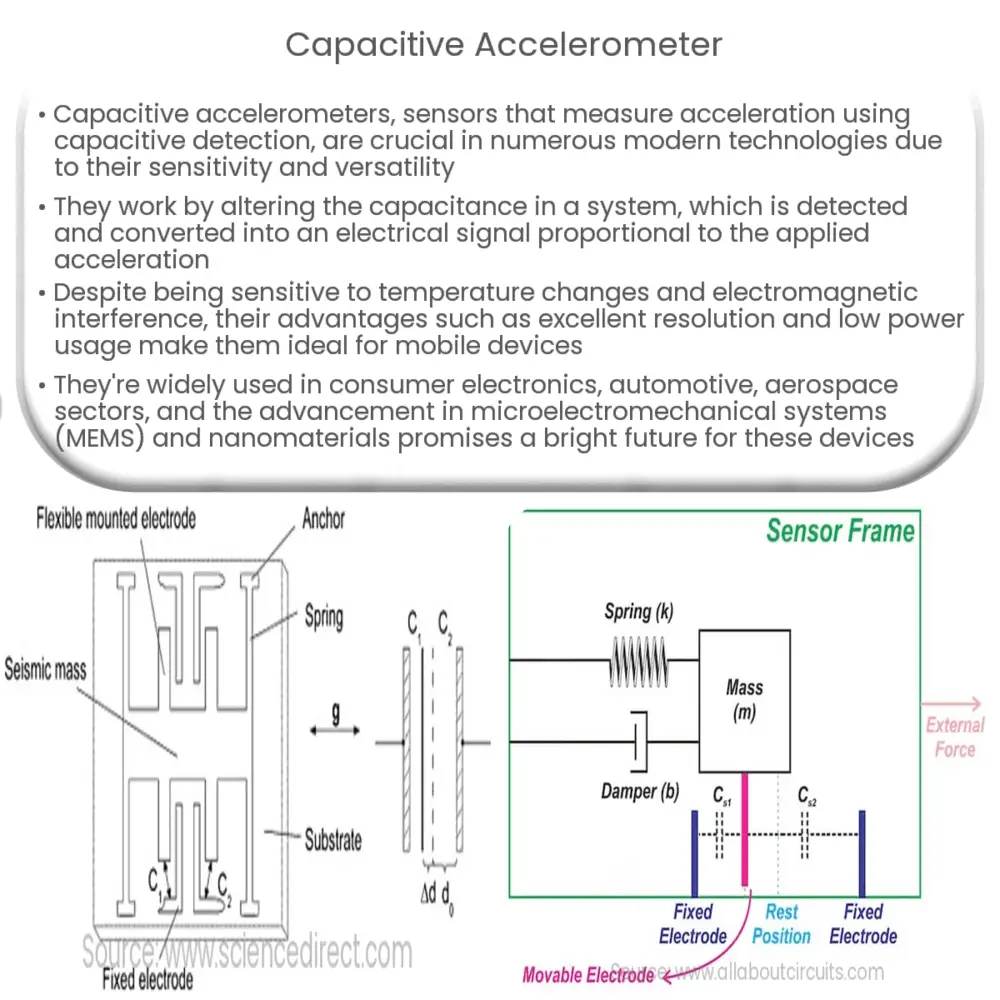Explore the inner workings of capacitive accelerometers, their advantages, applications in various industries, and future trends.

Understanding Capacitive Accelerometers
A capacitive accelerometer is a type of sensor that measures acceleration forces by means of capacitive detection. These forces may be static, like the constant force of gravity, or they could be dynamic, resulting from motion, shock, or vibration.
Essentially, a capacitive accelerometer functions based on the principle of capacitive sensing, which utilizes the electrical property of capacitance. Capacitance is the ability of a system to store an electric charge. The sensor incorporates a set of capacitor plates, often designed with a differential capacitive sensing technique for improved sensitivity and stability.
Design and Working Principle
The fundamental design of a capacitive accelerometer includes two fixed capacitor plates and a seismic mass. The seismic mass is essentially a movable capacitor plate suspended by a mechanical suspension system. The role of the seismic mass is to induce a relative displacement in response to external acceleration.
- Under zero acceleration conditions, the seismic mass stays in a neutral position, maintaining an equal distance between both the fixed capacitor plates. This results in equal capacitance for both sides.
- When acceleration is applied, the seismic mass displaces from its original position due to inertia. This causes an imbalance in the capacitive system, changing the distance between the plates and therefore altering the capacitance.
- The capacitance alteration is detected and converted into an electrical signal proportional to the applied acceleration.
Advantages and Disadvantages
- Advantages: Capacitive accelerometers are highly sensitive and are capable of detecting even minute changes in acceleration. They also have excellent resolution and a wide frequency range. Being low power devices, they are ideal for battery-operated applications such as mobile devices.
- Disadvantages: On the flip side, capacitive accelerometers are relatively sensitive to changes in temperature and can display non-linear output if not properly designed or controlled. They can also be sensitive to electromagnetic interference, although measures can be taken to shield the device and mitigate this effect.
Applications
Capacitive accelerometers have a vast range of applications due to their sensitivity, versatility, and affordability. They are widely used in consumer electronics like smartphones and gaming devices for features like screen orientation, motion sensing, and vibration feedback. In the automotive industry, they play a critical role in stability and crash detection systems. In the field of aerospace, they are integral for navigation, stability control, and shock detection.
The following section will delve deeper into the different applications of capacitive accelerometers, examining how they work in these contexts and discussing future trends and developments.
Detailed Applications of Capacitive Accelerometers
In the consumer electronics sector, capacitive accelerometers are used in handheld devices like smartphones and tablets. They help determine the orientation of the screen when it’s rotated and provide input for motion-based games and apps. Furthermore, these accelerometers are integral for features like step detection in fitness tracking applications.
The automotive industry leverages capacitive accelerometers in various ways. In the realm of vehicle stability control, these accelerometers measure lateral and longitudinal acceleration to help detect and manage skidding. They are also used in crash detection systems, where a sudden change in acceleration can trigger the deployment of airbags.
In the aerospace sector, capacitive accelerometers play a pivotal role in inertial navigation systems of aircraft and spacecraft. They measure acceleration due to changes in velocity and direction, feeding into the systems that maintain stability and direction control. They are also used for shock detection during launch and re-entry.
Future Trends and Developments
As technology evolves, so too does the sophistication of capacitive accelerometers. Developments in microelectromechanical systems (MEMS) technology have led to smaller, more efficient, and cost-effective accelerometers. This has broadened their application into new areas like health monitoring systems, where they can detect and measure human body movements, and in drone technology for flight stabilization.
In addition, advances in materials science, specifically in the domain of nanomaterials, may further enhance the sensitivity and performance of these devices. The future promises integrated solutions combining capacitive accelerometers with other sensor types for comprehensive sensing solutions.
Conclusion
In conclusion, capacitive accelerometers are versatile, sensitive, and crucial components in numerous modern technological applications. They allow devices to interact with their environment and users in more intuitive and sophisticated ways, paving the way for advancements in fields ranging from consumer electronics to automotive and aerospace technology. While these devices are not without their challenges, such as sensitivity to temperature variations and electromagnetic interference, ongoing research and development continue to enhance their performance and expand their possibilities. The future of capacitive accelerometers seems not only promising but also integral to the evolution of technology and its interaction with the physical world.

